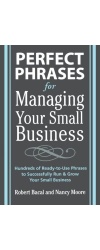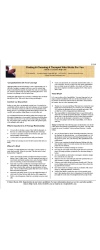Small shifts in mindset about managing performance and doing appraisals is all it takes.
Despite exhortations to abolish performance appraisals by experts, bloggers, and luminaries such as Edward Deming, and Coens & Jenkins, they are alive, if not well. They simply aren’t going away, so the question becomes: “How can companies, and managers get value from the review process that everyone seems to hate?” Is it even possible?
While performance appraisals are probably the biggest single waste of time, energy and resources that exist in the management toolkit, it IS possible to move the process from a dreaded, psychologically stressful “event”, to something that adds value to the organization, managers, and employees.
Here are eight ways to approach performance reviews so they’re actually worthwhile doing.
1. Think systems: Appraisals only work as part of a performance MANAGEMENT process that involves planning, communication, performance diagnosis and removing barriers to performance. On their own, and without these parts of the system, appraisals are indeed, like driving while looking in the rear view mirror.
2. Think WITH: Historically, appraisals have involved doing something TO employees, rather than working WITH employees. Is it surprising that nobody sees them as useful, when they pit manager versus employee?
3. Think People, Not Forms: The mechanisms for performance appraisal — the forms, and software are mistaken for the communication process that makes appraisals work. It’s become more important to complete the forms, rather than communicating effectively about performance. Focus on person-to-person communication, not getting the forms done.
4. Think Removing Barriers, Not Blaming: Performance appraisals don’t work if they are about “pinning the tail on the employee” to blame him or her. Appraisals work when manager and employee can work together to identify barriers to present or future performance, and work together to remove them. Often those barriers are beyond the control of employees and can only be addressed by manager and employee working together.
5. Acknowledge The Objectivity Myth: We like to believe we can measure the value of employee contributions objectively. We can’t. It’s easy to measure objectively, the trivial. It’s impossible to measure validly the value of an employee in objective ways. All evaluations attach subjectivity to the judgments.
6. Think Negotiation, Not Objectivity: If we can’t measure objectively, then the issue moves to engineering agreement between employee and manager about how to evaluate, and the goals and “objectives” for each employee. Employees need to be a part of defining their own jobs, what they need to accomplish, and determining what are meaningful ways to measure success.
7. Think Year Long Process, Not Event: Most organizations treat performance appraisals as events. That doesn’t work. In fact, the “performance appraisal event” is the least important part of improving performance. What IS important is the communication between manager and employee that occurs all year. Communication all year long should be informal, and need not be time consuming.
8. Think Feedback, Not Ratings: Ratings, the most common means of recording evaluations, are almost useless for improving performance, since they lack the specific information needed for employees to improve. By themselves ratings are hugely damaging, particularly if people believe they are somehow “objective”. If you are stuck with rating employees, augment with specifics.
Conclusion
 It shouldn’t surprise you that these eight things can take an unpleasant task and turn it into a positive helpful experience
It shouldn’t surprise you that these eight things can take an unpleasant task and turn it into a positive helpful experienceSince performance appraisals are so badly done, most managers, employees, and even HR professionals, have not experienced the power they can have, as part of a cooperative, problem-solving approach, to improve both employee and organization performance, while serving to engage employees, and put manager and employee ON THE SAME SIDE.
That IS the ultimate secret. When manager and employee feel they are on the same side, then the door to improving performance opens.






